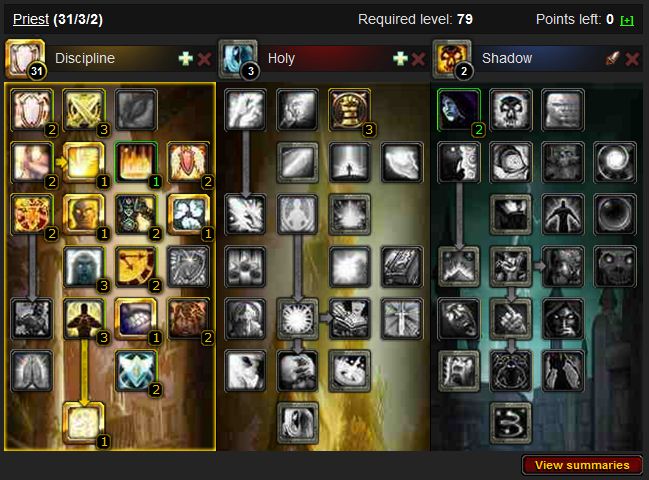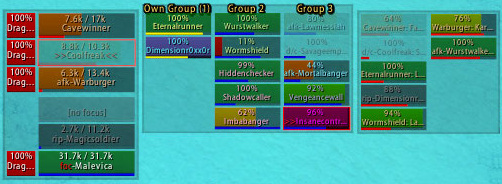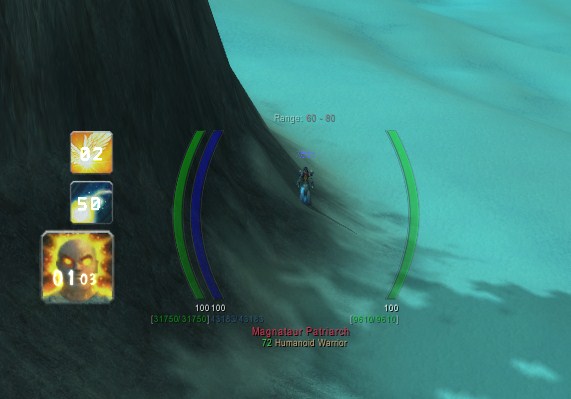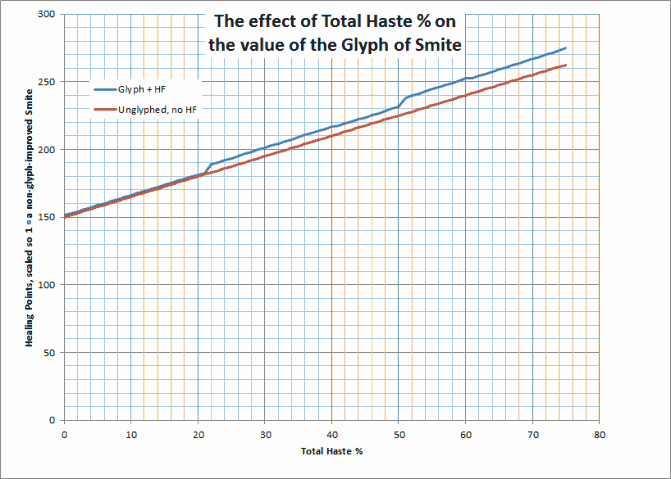
28th October, 2010: Updated quite a bit, having spent a couple of weeks to play around and raid. The first iteration misjudged a few aspects, particularly just how much mana we’d have and the value of Heal and talents that work with it. I think I’ve fixed that now, so it should line up better with the reality of 4.0.1.
Patch 4.0.1 is here, bringing with it some pretty big changes.
In this guide I’ll cover talents and sample specs, spell changes, stat changes, gems, enchants, glyphs and some technique pointers.
There’s still a lot of room for you to make your own choices to suit your playstyle and raid role, so engage your critical thinking skills before reading this or any guide. Also remember that this is still changing. Finally, this is aimed at level 80, not 85.
Feel free to correct me in the comments and I’ll try and keep the post updated.
Talent Specs
Something to remember throughout the 4.0.1 experience is that the systems we’re using are intended for level 85 rather than level 80, so if it feels a bit odd, that’s probably why.
Nowhere is this more true than in the case of talents, where you’re effectively 5 points short of where you’d like to be.
Standard 4.0.1 spec
http://www.wowhead.com/talent#bfMkrRsbcRMo0hZb:qmVdomMz

I’ve skipped Mental Agility in Tier 1, because mana is currently not a problem at all.
I’ve also put a single point in Inner Sanctum purely as filler, because I don’t see a huge need for this talent in the Wrath environment. It might prove invaluable in Cataclysm, but it’s just not valuable in WotLK.
I also skipped Strength of Soul. It’s a nice idea for a talent, but it’s essentially useless in 4.0.1 since you’ll rarely, if ever, use Heal. It’s simply ill-suited to the damage profile of the encounters.
The more straightforward omissions are Focused Will and Reflective Shield, because they’re PvP or solo talents, not raiding talents. Reflective shield only reflects damage absorbed by shields on you, and Focused Will is only useful if you’re getting physically hit, and you really shouldn’t be.
Evangelism, Archangel and Atonement, work to form the core of the Smite healing setup.
Matticus wrote about this in more depth recently, but the idea is that you can put out a good amount of healing at low cost by Smiting the boss and letting Atonement heal the tank. Pop Archangel to restore 15% of max mana whenever it’s off cooldown and Evangelism is stacked to 5.
Train of Thought – When you Smite, you reduce the cooldown of Penance by 0.5s. Assuming Smite is a 2s cast, and Penance has a 10s cooldown when glyphed, if you do nothing but Smite you can bring that Penance CD down to 8s instead. It’s not a bad talent at all.
Power Word: Barrier
The iconic spell, although currently it’s a little underpowered, since it’s used up and disappears in a very short amount of time. Use it selectively on small ground of people or location-specific effects, rather than on large raid-wide damage spikes.
Non-Smite alternative build
I had included a non-Smite build in here, but since you won’t be using Heal (so Strength of Soul is no use) and you don’t need the mana (no need for Mental Agility), realistically there isn’t anywhere to put the points freed up by dropping Atonement, Evangelism and Archangel.
I’d suggest keeping the same spec, and just using Flash Heal instead of Smiting, if you really don’t want to use Smite.
Sub-spec choices
Once you’ve got your 31 points in Discipline, you have a few choices for your sub-spec. You’ll only have 5 points to play with, so you’ll really have to choose the talents that suit your playstyle and role in raids.
In roughly descending order of interest:
Divine Fury – Reduces the cast time of Smite, Holy Fire, Heal and Greater Heal by 0.15s/0.35s/0.5s. If you’re going with the Smite/Heal healing model, this is probably your top priority. If you’re on bubble-bot duty, skip it.
Darkness – 1%/2%/3% haste. Divine Fury is more powerful for the points if you’re Smiting, so if you take that then you’ll only have 2 points left. Darkness is a good place for them though.
Empowered Healing – 5%/10%/15% healing to Flash Heal, Binding Heal, Heal and Greater Heal. I’d favour Darkness at level 80 because we use these spells so little, especially with a Smite healing model.
This is probably a good staple at 85, though.
Improved Renew – 5%/10% to your Renew. Not a Discipline talent, really.
Veiled Shadows – Reduces the cooldown of your Shadowfiend by 30s/60s. Not a good choice at 80, yet again because we just don’t need the mana.
To Smite, or not to Smite?
At the moment Smite healing is fun, different and very mana-efficient, and since you’ll be taking the points to support it in your spec anyway, I’d say give it a go.
If you really can’t stand it, then you can swap Flash Heal for Smite in your rotation for now.
Spell Changes
I might not touch on all of the little changes, but I’ll try and hit on the big ones.
Heal has been revamped with the goal of making it a viable filler spell at max level. It’s got the same cast time as Greater Heal, but heals for slightly less than a Flash Heal, and costs 9% of base mana compared to 28% for Flash Heal and 27% for Greater Heal.
So the new theoretical single-target heal set looks like:
However, in 4.0.1 mana is so plentiful and damage so high that a small, slow Heal simply isn’t needed. If you’re Disc with an Atonement build, you’ll use Smite instead of Flash Heal, wherever possible, or just substitute Flash Heal if you need direct healing instead.
Inner Fire hasn’t been changed much, but has had its charges removed so it’s simply a 30-minute self-buff now.
Prayer of Fortitude and Prayer of Shadow Protection have been removed because Power Word: Fortitude and Shadow Protection have been made raid/party-wide by default. What’s more, the reagent costs have been removed.
Although mana is not a problem at level 80, you might consider taking the Glyph of Fortitude as one of your minors now to avoid having to spend quite a large chunk of your precious mana to rebuff that rogue who stood in the whirlwind. There really aren’t any compelling alternatives anyway.
Power Word: Fortitude is also now equivalent to the Blood Pact buff provided by Warlocks’ Imps, and won’t stack with it or overwrite it.
Inner Focus has been given something of a revamp. It’s more restricted so now it’ll only give you a free Heal, Flash Heal, Greater Heal or Prayer of Healing (so your old Inner Focus + Divine Hymn macros are deprecated), but the cooldown has been slashed from 3 minutes to 45s.
I’m leaning towards treating this as a passive mana saving “proc” by macroing it to Flash Heal, Greater Heal and Prayer of Healing to save a big chunk of mana when it fires.
If you want to do this, here’s an example macro you could try:
#showtooltip Greater Heal
/console Sound_EnableSFX 0
/cast Inner Focus
/script UIErrorsFrame:Clear()
/console Sound_EnableSFX 1
/cast Greater Heal
Borrowed Time is down to 7%/14% from 5%/10%/15%/20%/25%. This changes the haste cap for bubble-spam. Quoting Medmal on PlusHeal:
The exact number is 830.02, so you’ll need 831 haste to be at the soft GCD cap with BT and Wrath of Air. Without Wrath of Air, the number is 1036. Remember that if you can spare the points, you can always spec Darkness to reduce these. With 3/3 Darkness and Wrath of Air, for example, the cap is only 711 (or 910, without Wrath of Air).
Power Word: Shield has had its base cooldown reduced to 3s (from 4s). Soul Warding allows you to subtract 1s/2s from this cooldown. However, you’re still limited by the global cooldown of 1.5s before haste, so it’s essentially no different to the current situation if you take 2/2 points here.
HoTs no longer clip if you refresh them just before the final tick, which is a great change. What happens instead when you overwrite an existing HoT the game allows the next scheduled tick to happen, then adds the “new” HoT time onto the end. You only get to finish the one next tick though, so unfortunately you can’t cast it a few times in succession and stack it up.
Refreshing a HoT also doesn’t reset the tick timer, so if your last tick was going to happen in 0.2s, it will occur 0.2s after you refresh the HoT as you’d expect, and the next tick will follow one tick interval after that.
Binding Heal has been changed slightly to take it back to its original positioning. In 3.3.5, Binding Heal cost almost twice as much as Flash Heal, but healed each target for slightly more than a Flash Heal. In 4.0.1 though, both cost roughly the same (BH: 1120 mana, FH: 1081 mana) and Binding Heal heals for 2 x 5k (8.9 HPM) while FH heals a single target for 8k (7.4 HPM). So if you’ll get the use out of both heals then Binding Heal is the way to go since it has better HPS and HPM, but you’ll get better performance out of Flash Heal if you’re not injured.
Stats
Spellpower
Spellpower is all but gone from gear, except for caster weapons (because they have a very high spellpower budget compared to any other slot), and has been converted to Intellect. You now get your spellpower directly from your Intellect, also at a 1:1 ratio.
The regen value of intellect has changed because Replenishment has been halved in effectiveness, from 1% of max mana over 5s in the 3.3.5 version to 1% of max mana over 10s in the 4.0.1 version. You may notice your regen taking a bit of a hit if you’re very Int-heavy, but as I’ve said elsewhere, mana is so plentiful that you probably won’t.
Because Intellect is now a throughput stat, taking the place of spellpower, it has become a red gem instead of yellow.
MP5 and Spirit
MP5 is gone as a stat, and every healer is getting Meditation just for picking the Holy, Discipline or Restoration tree to spend 31 points in. As a result Spirit is our only pure regen stat.
However, I’d not recommend stacking it in 4.0.1 because you just don’t need the regen at the moment. Focus on the throughput stats instead.
Haste
Because of the change to Borrowed Time I talked about earlier, if you’re continuing in the bubble-bot role Disc Priests play in current content, you’ll want to get your hands on a bit more haste. Repeating from earlier, you’ll now need 831 haste with BT and Wrath of Air, or 1036 without WoA.
If you’re having trouble, you can take points in Darkness in the Shadow tree, which will take the haste rating requirement down to 790/750/711 with WoA or 993/951/910 without it. Although given the low value of spirit at the moment, reforging that into haste should get you there.
The big change to haste itself is the way it now affects HoTs, DoTs and channelled spells. I’ve gone into a lot more detail in another post (it’s focused on level 85, but the principles are the same), but the short version is that haste reduces the time between ticks so the spell can finish early, and if you reach the point where you would be able to fit an additional half a tick in, you get an extra full tick and the duration is extended accordingly
.
For Priests that means that you get an extra Penance tick at 25% total haste (from gear, buffs and Borrowed Time combined) [on 4.0.1 Live this appears not to be the case. I got to 54.6% total haste and still only got 3 ticks. This is not what was happening on the beta, so it might be a bug], and an extra Renew tick at 12.5% and 37.5%. The table below shows the haste rating you need from your gear to reach these breakpoints:
| Spell |
Rating with no buffs |
Rating with BT |
Rating with WoA |
Rating with BT and WoA |
| Penance |
820 |
317 |
625 |
146 |
| Renew (1 extra) |
410 |
0 |
235 |
0 |
| Renew (2 extra) |
1230 |
676 |
1015 |
488 |
Crit
Crit chance is now also applied to HoT ticks by default, so expect to see Renew crits popping up quite a bit along with Divine Aegis bubbles.
Divine Aegis remains unchanged.
Mastery
You won’t find Mastery on gear before Cataclysm lands, but the stat is available in 4.0.1 and is quite handy to have at the moment.
The Disc Priest Mastery is Shield Discipline, which increases the potency of all your damage absorption spells by 20%. Once you start getting Mastery Rating on gear it will convert to Mastery points, and each of these will add a further 2.5% absorption.
Priority
Our stat priority in 4.0.1 is roughly the same as in 3.3.5, namely:
Int > Haste (to cap) > Spirit (until you don’t have mana problems) > Crit (if you tank heal) or Mastery (if you bubble more).
If you’re raiding ICC in the right sort of gear you won’t have mana problems, so Spirit is not valuable right now.
Reforging
Reforging is new in 4.0.1. This allows you, by talking to an NPC found in Enchanting shops, to convert up to 40% of a secondary stat (Spirit, Haste, Hit, Crit, Mastery) on an item into another secondary stat not currently found on the item. The process is fully reversible.
At the moment the main target for Reforging is turning as much Spirit as you can spare into Haste to get to the soft cap and then Mastery to bring your bubbles back up to where they used to be.
If you want or need more, especially if you’re a raid-healing Disc Priest, you might also reforge some Crit into Haste or Mastery as well.
Gemming
Gems have been converted automagically into their new variants. The Disc staples are affected as follows:
As for meta gems, the Insightful Earthsiege Diamond hasn’t changed, but the Ember Skyflare Diamond has had its 25 SP converted into 21 Intellect, and the 2% intellect has become 2% maximum mana.
Because of these conversions, you might find that you’ve lost your yellow gems, so putting a Reckless Ametrine in will help you meet the Insightful Earthsiege Diamond requirement.
Enchanting
None of the standard enchants have changed, and since SP or Int are still our top stats I see no reason to change.
Glyphing
Glyphing has changed dramatically with 4.0.1. You now learn glyphs by using them, and from then on they’re added to your glyphs pane for use in the future. Swapping them around requires a Vanishing Powder at level 80, and a Dust of Disappearance from 81 onwards which you’ll need to carry around, but it’s a lot easier than carrying around several stacks of different glyphs.
There are also now three types of glyphs instead of two: Prime Glyphs are the spec-defining, high-impact ones; Major Glyphs are more utility-focused but still significant; and Minor Glyphs are as unexciting as ever.
At level 80, you’ll have access to all 9 slots, 3 for each type of glyph.
Here’s the 4.0.1 glyphs for a Disc Priest, in descending order of interest.
Prime
Glyph of Penance – Mandatory. Penance has huge HPS and HPM, and anything that lets you use it more often is a must-have.
Glyph of Power Word: Shield – Not changed since 3.3.5. Still a nice glyph, and definitely a strong contender still.
Glyph of Power Word: Barrier – Since PW:B will become your emergency cooldown, your version of Divine Sacrifice, the 10% healing boost you get from this glyph is nice, especially in a raid.
Glyph of Prayer of Healing – Leaving a lingering HoT is really useful if you use PoH from time to time.
Glyph of Flash Heal – Since Flash Heal’s niche is being shifted to emergency healing this glyph might prove useful at 85, but not in 4.0.1 where heals are still large relative to health pools and people aren’t under 50% health for long.
Glyph of Renew – Changed from 3.3.5 to be a flat 10% boost to your Renew. If you use Renew this is very powerful, if you don’t then it’s not.
My top pick would be Penance. Other than that, I’d recommend Power Word: Shield and then Prayer of Healing. I’d love to recommend Power Word: Barrier, but on Live PW:B isn’t lasting very long (a couple of seconds in most cases) so using the bonus healing is tricky.
Major
As I’ve already said, Major glyphs are generally situational. Keep as many available as you can, and swap them in and out as appropriate. I’ve put some usage notes in this section.
Glyph of Dispel Magic – If you’re dispelling a lot, the healing is a nice bonus.
Glyph of Divine Accuracy – Increases your Hit chance with Smite by 18%. Pretty much mandatory if you’re using the Smite healing style, not useful (obviously) if you’re not.
Glyph of Holy Nova – Holy Nova heals the raid now (it’s range-limited only) making it much more useful than before. This glyph is a very powerful boost to the spell. I’d recommend it.
Glyph of Mass Dispel – Replaces the old Focused Power talent, making a quick MD cast available to all Priest specs rather than just Disc. I like this for convenience, but it’s not really a performance boost and definitely optional.
Glyph of Fear Ward – On bosses that fear this could prove invaluable, especially in smaller group sizes when a rotation won’t be practical. Highly situational, but if you run 10s without a Tremor Totem available this could save your bacon.
Glyph of Inner Fire – Not one to bother with in PvE, but the armour bonus will probably be very useful for PvP.
Glyph of Pain Suppression – Another PvP glyph, since stuns in PvE aren’t usually fatal.
Glyph of Psychic Scream – This one’s very interesting, making feared targets stand still rather than running away. Nice in heroics as safer emergency CC, but definitely not a raid glyph.
Glyph of Smite – Because of the lowered duration of Holy Fire from 12s to 7s, this glyph is not an especially good choice, because the HPS gain from the glyph is approximately cancelled out by the HPS loss from casting HF. It’s a positive but small HPS boost if you Smite for the entire duration, and definitely a DPS gain, but not much of one.
I wrote a bit more about this elsewhere.
Minor
Glyph of Fortitude – As I mentioned earlier, since Power Word: Fortitude is now raid-wide and its cost is quite high, this one might be a good choice to save a ton of mana rebuffing someone who dies during a fight.
Glyph of Levitate – As with WotLK, it’s one of the more practical minor glyphs.
Glyph of Fading – You might find yourself fading more than in WotLK, and some reports say this is the case, although I’ve not found this personally. You shouldn’t need it in a raid, really.
Glyph of Shackle Undead – If you need the extra 5 yards to avoid body-pulling, then grab this glyph.
Glyph of Shadow Protection – Since Shadow Protection now lasts for an hour, I see zero value in this glyph. I imagine it’ll be changed at some stage, maybe to line up with the Fortitude glyph.
Glyph of Shadowfiend – Another less-than-useful glyph, since they changed the Shadowfiend to not take AoE damage. Probably not worth the cost.
From this selection I’d pick up Fortitude and Levitate as mandatory glyphs, and then I’m picking between Shackle Undead if I’m using Shackle, or Shadowfiend if I’m not.
Healing Tips
The first thing to say is that generally speaking, people’s experiences with the PTR suggest that you won’t need to change too much of your healing until Cataclysm itself.
Discipline Priests did not get changed anything like as significantly as other specs, and with mana not being constrained at al in 4.0.1 there’s no particular need to change.
There’s some mileage in thinking about how you’ll include Heal in you bindings and maybe trying to establish some muscle memory, but if you try and heal Cataclysm-style in 4.0.1 you’ll struggle a lot.
Tank Healing
If you’re going the Smiting route, your baseline healing on the tank comes from Smiting the boss and letting Atonement heal the lowest-health player with 8 yards of the boss, which ought to be the tank, and using Penance, PW:S and PoM on the tank whenever they’re available. Pop Archangel when it’s at 5 stacks to get 15% of your maximum mana returned and that 15% boost to healing.
If you decide not to use the Smite mechanics, just substitute Flash Heal into the above.
If you’ve taken Train of Thought and Inner Focus, remember to watch the IF cooldown or macro it to your two expensive heals to get the most benefit from it.
The thing to be careful of is checking that Atonement is actually working. Tanks have to stand very close to be within 8 yards of the boss, so they might be out of range, or melee might be taking damage and be soaking up the Atonement heals. In these cases if you’re needed on the tanks then you’ll have to switch to healing them directly.
Raid Healing
Bubbling is still fairly viable, although you’ll want to reforge a lot of Haste and Mastery onto your gear to match the performance you used to get in 3.3.5. I’d use Flash Heal or Penance for spot heals, since mana is not a problem.
The simultaneous Rapture proc trick still works, and the internal cooldown’s reduced to 6s now, so you’ll see a lot more Rapture returns.
Power Word: Barrier ought to be a really nice cooldown like Divine Sacrifice was, but unfortunately it’s just not lasting in raids at the moment so it’s only especially useful on the melee or tanks.
Possibly Related Posts:









